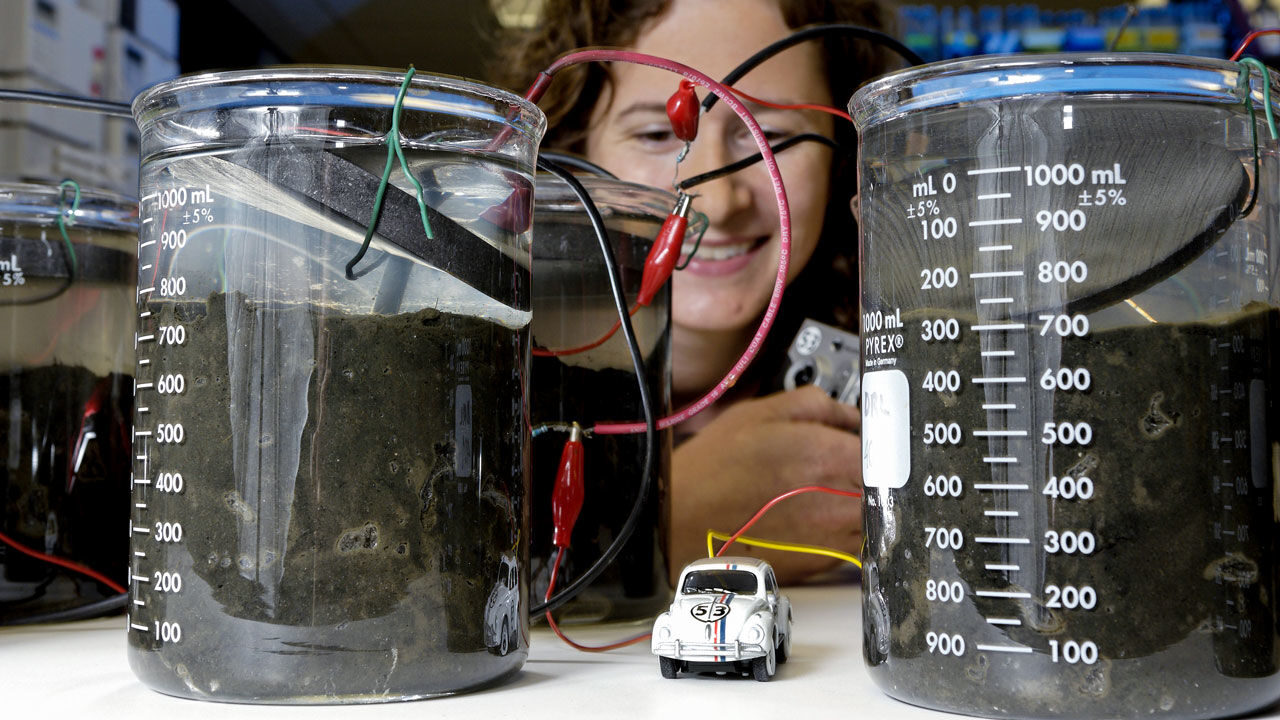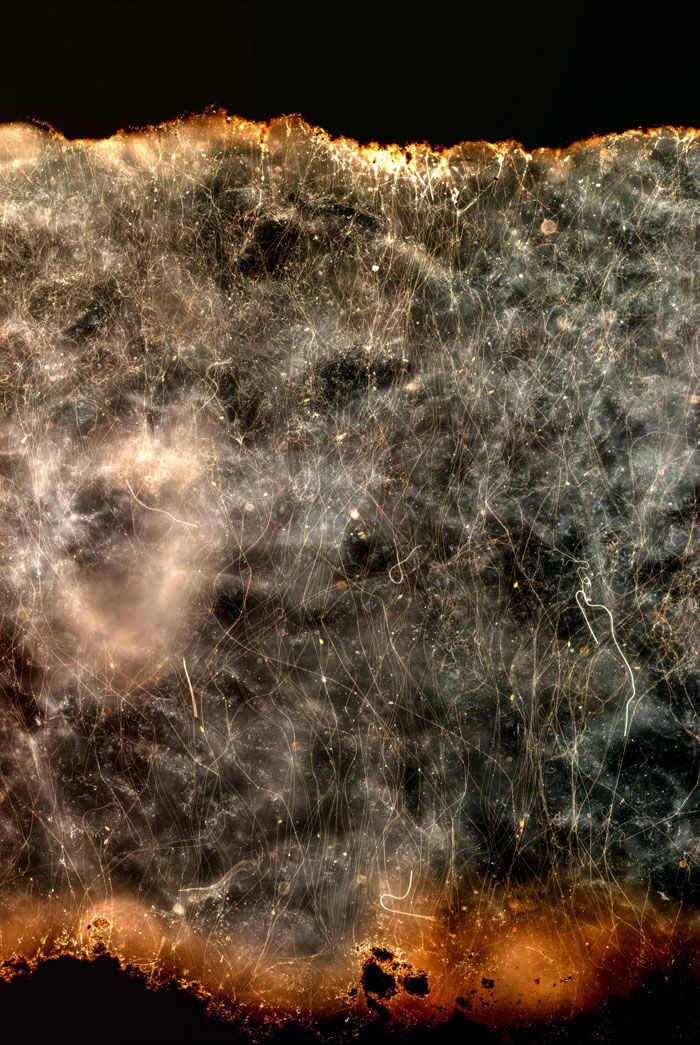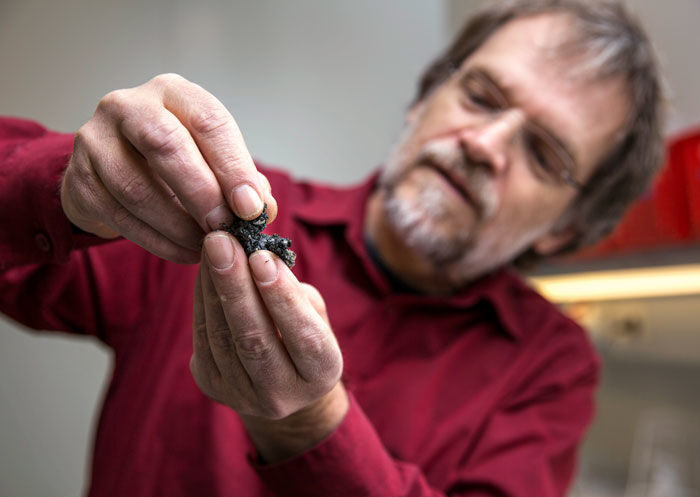
The first explanation, he says, was that the sensors were wrong. But the cause turned out to be far stranger: bacteria that join cells end to end to build electrical cables able to carry current up to 5 centimeters through mud. The adaptation, never seen before in a microbe, allows these so-called cable bacteria to overcome a major challenge facing many organisms that live in mud: a lack of oxygen. Its absence would normally keep bacteria from metabolizing compounds, such as hydrogen sulfide, as food. But the cables, by linking the microbes to sediments richer in oxygen, allow them to carry out the reaction long distance.
When Nielsen first described the discovery in 2009, colleagues were skeptical. Filip Meysman, a chemical engineer at the University of Antwerp, recalls thinking, "This is complete nonsense." Yes, researchers knew bacteria could conduct electricity, but not over the distances Nielsen was suggesting. It was "as if our own metabolic processes would have an effect 18 kilometers away," says microbiologist Andreas Teske of the University of North Carolina, Chapel Hill.
But the more researchers have looked for "electrified" mud, the more they have found it, in both saltwater and fresh. They have also identified a second kind of mud-loving electric microbe: nanowire bacteria, individual cells that grow protein structures capable of moving electrons over shorter distances. These nanowire microbes live seemingly everywhere — including in the human mouth.

Most cells thrive by robbing electrons from one molecule, a process called oxidation, and donating them to another molecule, usually oxygen — so-called reduction. Energy harvested from these reactions drives the other processes of life. In eukaryotic cells, including our own, such "redox" reactions take place on the inner membrane of the mitochondria, and the distances involved are tiny — just micrometers. That is why so many researchers were skeptical of Nielsen's claim that cable bacteria were moving electrons across a span of mud equivalent to the width of a golf ball.
The vanishing hydrogen sulfide was key to proving it. Bacteria produce the compound in mud by breaking down plant debris and other organic material; in deeper sediments, hydrogen sulfide builds up because there is little oxygen to help other bacteria break it down. Yet, in Nielsen's laboratory beakers, the hydrogen sulfide was disappearing anyway. Moreover, a rusty hue appeared on the mud's surface, indicating that an iron oxide had formed.
One night, waking from his sleep, Nielsen came up with a bizarre explanation: What if bacteria buried in the mud were completing the redox reaction by somehow bypassing the oxygen-poor layers? What if, instead, they used the ample supplies of hydrogen sulfide as an electron donor, then shuttled the electrons upward to the oxygen-rich surface? There, the oxidation process would produce rust if iron was present.
Finding what was carrying these electrons proved complicated. First, Nils Risgaard-Petersen on Nielsen's team had to rule out a simpler possibility: that metallic particles in the sediment were shuttling electrons to the surface and causing the oxidation. He accomplished that by inserting a layer of glass beads, which don't conduct electricity, into a column of mud. Despite that obstacle, the researchers still detected an electric current moving through the mud, suggesting metallic particles were not the conductor.
To see whether some kind of cable or wire was ferrying electrons, the researchers next used a tungsten wire to make a horizontal slice through a column of mud. The current flickered out, as if a wire had been snipped. Other work narrowed down the conductor's size, suggesting it had to be at least 1 micrometer in diameter. "That's the conventional size for bacteria," Nielsen says.
Ultimately, electron micrographs revealed a likely candidate: long, thin, bacterial filaments that appeared in the layer of glass beads inserted in the beakers filled with the Aarhus Harbor mud. Each filament was composed of a stack of cells — up to 2000 — encased in a ridged outer membrane. In the space between that membrane and the stacked cells, many parallel "wires" stretched the length of the filament. The cablelike appearance inspired the microbe's common name.
Meysman, the one-time skeptic, quickly became a convert. Not long after Nielsen announced his discovery, Meysman decided to examine one of his own marine mud samples. "I noticed the same color changes in the sediment that he saw," Meysman recalls. "It was an instruction from Mother Nature to take this more seriously."
His team began to develop tools and techniques for investigating the microbes, sometimes working collaboratively with Nielsen's group. It was tough going. The bacterial filaments tended to degrade quickly once isolated, and standard electrodes for measuring currents in small conductors didn't work. But once the researchers learned how to pick out a single filament and quickly attach a customized electrode, "We saw really high conductivity," Meysman says. The living cables don't rival copper wires, he says, but they are on par with conductors used in solar panels and cellphone screens, as well as the best organic semiconductors.
The researchers also dissected the cable bacteria's anatomy. Using chemical baths, they isolated the cylindrical sheath, finding it holds 17 to 60 parallel fibers, glued along the inside. The sheath is the source of the conductance, Meysman and colleagues reported last year in Nature Communications. Its exact composition is still unknown, but could be protein-based.
"It's a complicated organism," says Nielsen, who now heads a Center for Electromicrobiology, established in 2017 by the Danish government. Among the challenges the center is tackling is mass producing the microbes in culture. "If we had a pure culture, it would be a lot easier" to test ideas about cell metabolism and environmental influences on conductance, says the center's Andreas Schramm. Cultured bacteria would also make it easier to isolate the cable's wires and test potential applications for bioremediation and biotechnology.
Even as researchers puzzle over cable bacteria, others have been studying another big player in electric mud: nanowire bacteria, which instead of stacking cells into cables sprout protein wires spanning 20 to 50 nanometers from each cell.
As with cable bacteria, some puzzling sediment chemistry led to the discovery of nanowire microbes. In 1987, microbiologist Derek Lovley, now at the University of Massachusetts, Amherst, was trying to understand how phosphate from fertilizer runoff — a nutrient that promotes algal blooms — is released from sediments beneath the Potomac River in Washington, D.C. He suspected microbes were at work and began to sieve them from the mud. After growing one, now called Geobacter metallireducens, he noticed (under an electron microscope) that the bacteria sprouted connections to nearby iron minerals. He suspected these wires were transporting electrons, and eventually figured out that Geobacter orchestrates chemical reactions in mud by oxidizing organic compounds and transferring the electrons to minerals. Those reduced minerals then release their hold on phosphorus and other elements.
Special issue: A world of mud
Like Nielsen, Lovley faced skepticism when he first described his electrical microbe. Today, however, he and others have documented almost a dozen kinds of nanowire microbes, finding them in a variety of environments besides mud. Many shuttle electrons to and from particles in sediment. But some rely on other microbes to obtain or store electrons. Such biological partnerships allow both microbes to "do new types of chemistry that neither organism can do on their own," says Victoria Orphan, a geobiologist at the California Institute of Technology. Whereas cable bacteria solve their redox requirements by long-distance transport to oxygenated mud, these microbes depend on each other's metabolisms to satisfy their redox needs.
Some researchers are still debating how the bacterial nanowires conduct electrons. Lovley and his colleagues are convinced that chains of proteins called pilins, which consist of ring-shaped amino acids, are key. When he and his colleagues reduced the number of ringed amino acids in pilin, the nanowires became poorer conductors. "That was really surprising," Lovley says, because proteins are generally thought to be insulators. But others think the issue is far from settled. Orphan, for one, says that although "there is some compelling evidence ... I still don't think [nanowire conductance] is well understood."
What is clear is that electrical bacteria are everywhere. In 2014, for example, scientists found cable bacteria in three very different habitats in the North Sea: an intertidal salt marsh, a seafloor basin where oxygen levels drop to near zero at some times of the year, and a submerged mud plain just off the coast. (They didn't find them in a sandy area populated by worms that stir up the sediments and disrupt the cables.) Elsewhere, researchers have found DNA evidence of cable bacteria in deep, oxygen-poor ocean basins, hydrothermal vent areas, and cold seeps, as well as mangrove and tidal flats in both temperate and subtropical regions.
Cable bacteria have also shown up in freshwater environments. After reading Nielsen's papers in 2010 and 2012, a team led by microbiologist Rainer Meckenstock re-examined sediment cores drilled during a study of groundwater pollution in Dusseldorf, Germany. "We found [cable bacteria] exactly where we thought we would find them," at depths where oxygen was depleted, recalls Meckenstock, who works at the University of Duisburg-Essen.
Nanowire bacteria are even more broadly distributed. Researchers have found them in soils, rice paddies, the deep subsurface, and even sewage treatment plants, as well as freshwater and marine sediments. They may exist wherever biofilms form, and the ubiquity of biofilms provides further evidence of the big role these bacteria may play in nature.
The broad range of electric mud bacteria also suggest they are a major force in ecosystems. By preventing the buildup of hydrogen sulfide, for example, cable bacteria are likely making mud more habitable for other life forms. Meckenstock, Nielsen, and others have found them on or near the roots of seagrasses and other aquatic plants, which bubble off oxygen that the bacteria likely exploit to break down hydrogen sulfide. That, in turn, protects the plants from toxic gas. The partnership "seems to be a very generic property of water plants," Meckenstock says.
Robert Aller, a marine biogeochemist at Stony Brook University, thinks the bacteria may also aid many undersea invertebrates, including worms that build burrows that allow oxygenated water to flow into the mud. He has discovered cable bacteria sticking out the sides of worm tubes, likely so they can tap that oxygen for electron storage. In return, those worms are kept safe from the toxic hydrogen sulfide. "The bacteria make [the burrow] more livable," says Aller, who described these connections in a July 2019 paper in Science Advances.
The microbes also alter the properties of mud, says Sairah Malkin, an ecologist at the University of Maryland Center for Environmental Science. "They are particularly efficient ... ecosystem engineers." Cable bacteria "grow like wildfire," she says; on intertidal oyster reefs, she has found, a single cubic centimeter of mud can contain 2859 meters of cables, which cements particles in place, possibly making sediment more stable for marine organisms.
The bacteria also alter the mud's chemistry, making layers closer to the surface more alkaline and deeper layers more acidic, Malkin has found. Such pH gradients can affect "numerous geochemical cycles," she says, including those involving arsenic, manganese, and iron, creating opportunities for other microbes.
With vast swaths of the planet covered by mud, cable and nanowire bacteria are likely having an influence on global climate, researchers say. Nanowire bacteria, for example, can strip electrons from organic materials, such as dead diatoms, then shuttle them to other bacteria that produce methane — a potent greenhouse gas. Under different circumstances, cable bacteria can reduce methane production.
In coming years, "We are going to see a broad acceptance of the importance of these microbes to the biosphere," Malkin says. Just over a decade after Nielsen noticed the mysterious disappearance of hydrogen sulfide from the Aarhus mud, he says, "It is dizzying to think about what we're dealing with here."
Next up: a phone powered by microbial wires?
The discoverers of electric microbes have been quick to think about how these bacteria could be put to work. "Now that we have found out that evolution has managed to make electrical wires, it would be a shame if we didn't use them," says Lars Peter Nielsen, a microbiologist at the University of Aarhus.
One potential use is to detect and control pollutants. Cable microbes seem to thrive in the presence of organic compounds, such as petroleum, and Nielsen and his team are testing the possibility that an abundance of cable bacteria signals the presence of undetected pollution in aquifers. The bacteria don't degrade the oil directly, but they may oxidize sulfide produced by other oil-eating bacteria. They might also aid cleanup; sediments recover faster from crude oil contamination when they are colonized by cable bacteria, a different research team reported in January in Water Research. In Spain, a third team is exploring whether nanowire bacteria can speed the cleanup of polluted wetlands. And even before nanowire bacteria were shown to be electric, they showed promise for decontaminating nuclear waste sites and aquifers contaminated with aromatic hydrocarbons such as benzene or naphthalene.
Electric bacteria could also give rise to new technologies. They can be genetically modified to alter their nanowires, which could then be sheared off to form the basis of sensitive, wearable sensors, says Derek Lovley, a microbiologist the University of Massachusetts (UMass), Amherst. "We can design nanowires and tailor them to specifically bind compounds of interest." For example, in the 11 May issue of Nano Research, Lovely, UMass engineer Jun Yao, and their colleagues described a nanowire sensor that detects ammonia at concentrations relevant for agricultural, industrial, environmental, and biomedical applications.
Fashioned into a film, nanowires can generate electricity from the moisture in the air. The film generates power, researchers believe, when a moisture gradient develops between the film's upper and lower edges. (The upper edge is more exposed to moisture.) As the water's hydrogen and oxygen atoms separate because of the gradient, a charge develops and electrons flow. Yao and his team reported on 17 February in Nature that such a film can create enough power to light a light-emitting diode, and 17 such devices connected together can power a cellphone. The approach is "a revolutionary technology to get renewable, green, and cheap energy," says Qu Liangti, a materials scientist at Tsinghua University. (Others are more cautious, noting that past attempts to wring energy from moisture, using graphene or polymers, have not panned out.)
Ultimately, researchers hope to exploit the bacteria's electrical talents without having to deal with the finicky microbes themselves. Lovley, for example, has coaxed a common lab and industrial bacterium, Escherichia coli, to make nanowires. That should make it easier for researchers to mass produce the structures and explore practical applications.
doi:10.1126/science.abe3910




Comment: See also:
- Fungi that absorbs radiation has been growing all over Chernobyl plant
- Tomato plants send electrical signals to each other through fungi
- Some bacteria sacrifice themselves to protect their brethren from antibiotics
And check out SOTT radio's: The Truth Perspective: Are Cells the Intelligent Designers? Why Creationists and Darwinists Are Both Wrong